Operation Management Techniques and Practices at Tesco
VerifiedAdded on 2023/06/09
|12
|3684
|416
Essay
AI Summary
This essay provides a detailed analysis of operation management activities within Tesco, a major retail firm, focusing on techniques and practices that enhance business performance. It examines operations scheduling, including forward and backward scheduling, and layout planning, which optimizes resource allocation and space utilization. The essay also discusses inventory management and its role in tracking stock levels and improving overall processes. By exploring these key areas, the analysis highlights how effective operations management contributes to increased productivity, profitability, and customer satisfaction within Tesco. Desklib offers a platform for students to access this and other solved assignments.

Operation
Management
Management
Paraphrase This Document
Need a fresh take? Get an instant paraphrase of this document with our AI Paraphraser
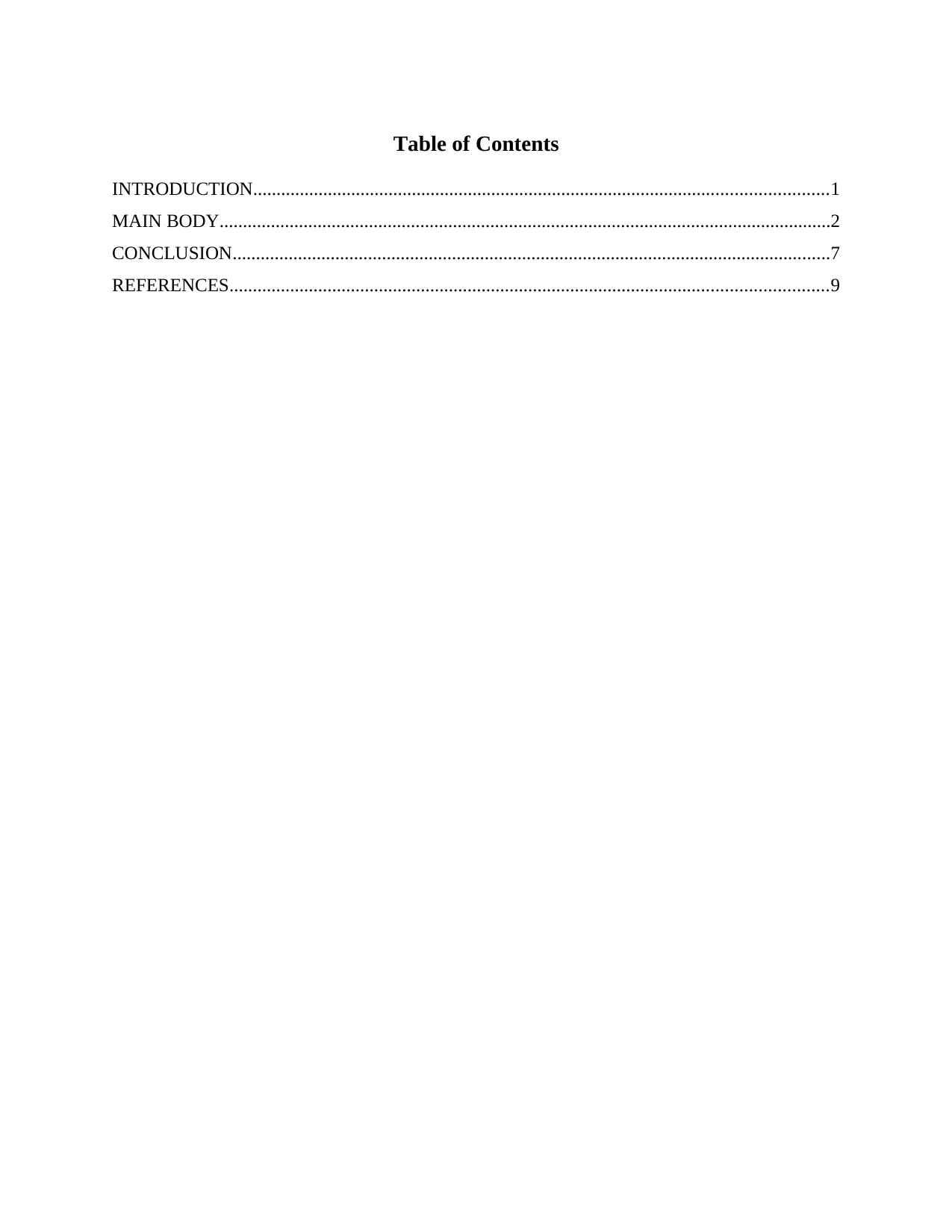
Table of Contents
INTRODUCTION...........................................................................................................................1
MAIN BODY...................................................................................................................................2
CONCLUSION................................................................................................................................7
REFERENCES................................................................................................................................9
INTRODUCTION...........................................................................................................................1
MAIN BODY...................................................................................................................................2
CONCLUSION................................................................................................................................7
REFERENCES................................................................................................................................9
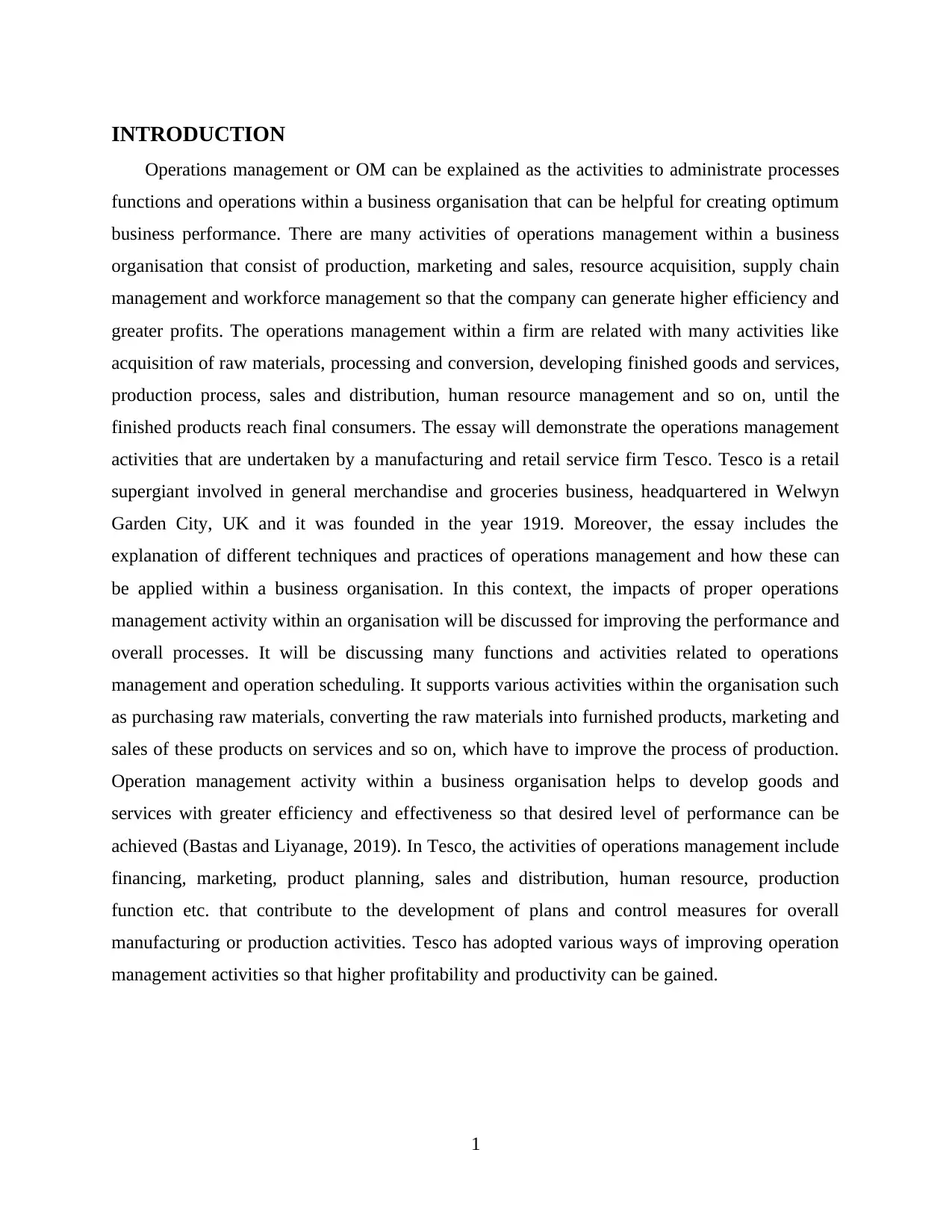
INTRODUCTION
Operations management or OM can be explained as the activities to administrate processes
functions and operations within a business organisation that can be helpful for creating optimum
business performance. There are many activities of operations management within a business
organisation that consist of production, marketing and sales, resource acquisition, supply chain
management and workforce management so that the company can generate higher efficiency and
greater profits. The operations management within a firm are related with many activities like
acquisition of raw materials, processing and conversion, developing finished goods and services,
production process, sales and distribution, human resource management and so on, until the
finished products reach final consumers. The essay will demonstrate the operations management
activities that are undertaken by a manufacturing and retail service firm Tesco. Tesco is a retail
supergiant involved in general merchandise and groceries business, headquartered in Welwyn
Garden City, UK and it was founded in the year 1919. Moreover, the essay includes the
explanation of different techniques and practices of operations management and how these can
be applied within a business organisation. In this context, the impacts of proper operations
management activity within an organisation will be discussed for improving the performance and
overall processes. It will be discussing many functions and activities related to operations
management and operation scheduling. It supports various activities within the organisation such
as purchasing raw materials, converting the raw materials into furnished products, marketing and
sales of these products on services and so on, which have to improve the process of production.
Operation management activity within a business organisation helps to develop goods and
services with greater efficiency and effectiveness so that desired level of performance can be
achieved (Bastas and Liyanage, 2019). In Tesco, the activities of operations management include
financing, marketing, product planning, sales and distribution, human resource, production
function etc. that contribute to the development of plans and control measures for overall
manufacturing or production activities. Tesco has adopted various ways of improving operation
management activities so that higher profitability and productivity can be gained.
1
Operations management or OM can be explained as the activities to administrate processes
functions and operations within a business organisation that can be helpful for creating optimum
business performance. There are many activities of operations management within a business
organisation that consist of production, marketing and sales, resource acquisition, supply chain
management and workforce management so that the company can generate higher efficiency and
greater profits. The operations management within a firm are related with many activities like
acquisition of raw materials, processing and conversion, developing finished goods and services,
production process, sales and distribution, human resource management and so on, until the
finished products reach final consumers. The essay will demonstrate the operations management
activities that are undertaken by a manufacturing and retail service firm Tesco. Tesco is a retail
supergiant involved in general merchandise and groceries business, headquartered in Welwyn
Garden City, UK and it was founded in the year 1919. Moreover, the essay includes the
explanation of different techniques and practices of operations management and how these can
be applied within a business organisation. In this context, the impacts of proper operations
management activity within an organisation will be discussed for improving the performance and
overall processes. It will be discussing many functions and activities related to operations
management and operation scheduling. It supports various activities within the organisation such
as purchasing raw materials, converting the raw materials into furnished products, marketing and
sales of these products on services and so on, which have to improve the process of production.
Operation management activity within a business organisation helps to develop goods and
services with greater efficiency and effectiveness so that desired level of performance can be
achieved (Bastas and Liyanage, 2019). In Tesco, the activities of operations management include
financing, marketing, product planning, sales and distribution, human resource, production
function etc. that contribute to the development of plans and control measures for overall
manufacturing or production activities. Tesco has adopted various ways of improving operation
management activities so that higher profitability and productivity can be gained.
1
⊘ This is a preview!⊘
Do you want full access?
Subscribe today to unlock all pages.

Trusted by 1+ million students worldwide
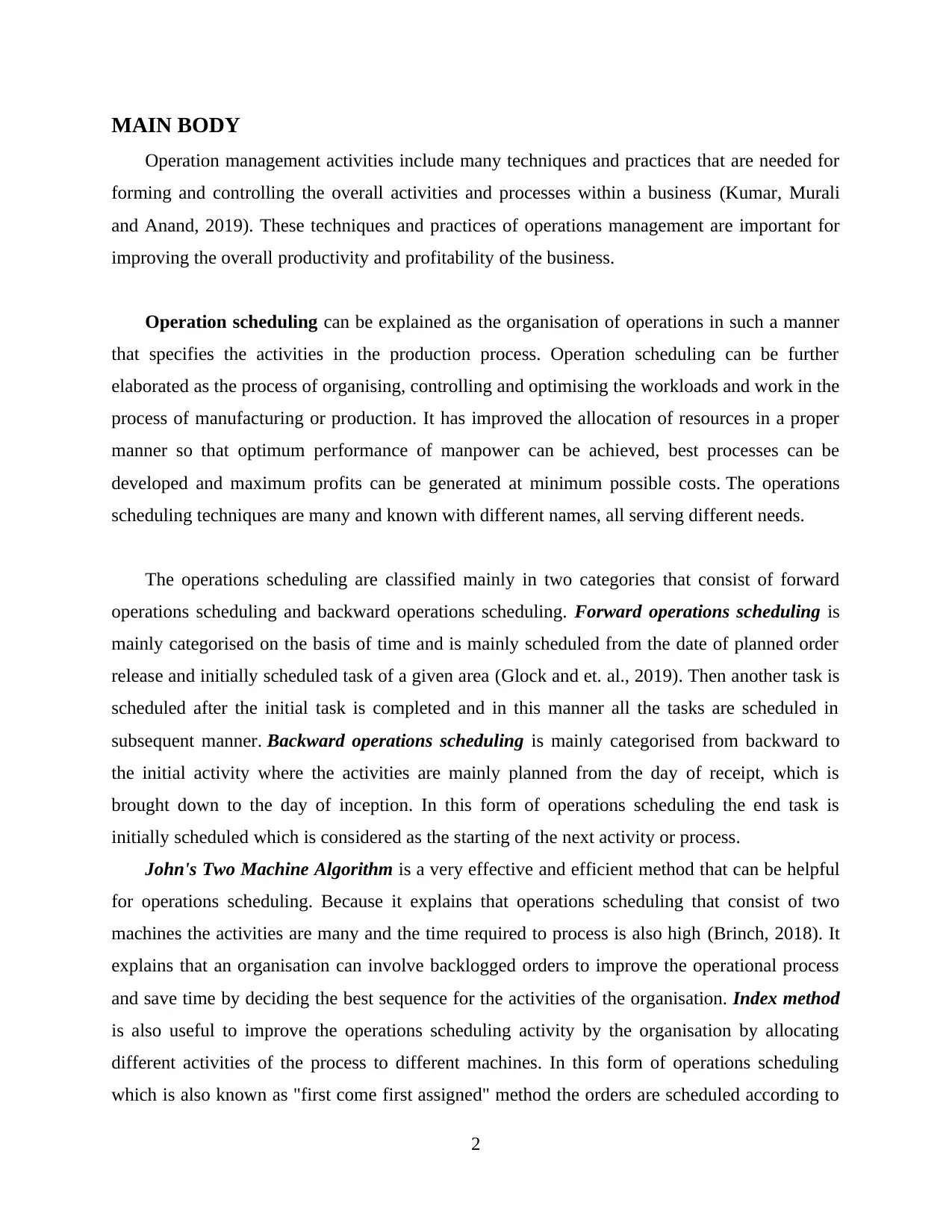
MAIN BODY
Operation management activities include many techniques and practices that are needed for
forming and controlling the overall activities and processes within a business (Kumar, Murali
and Anand, 2019). These techniques and practices of operations management are important for
improving the overall productivity and profitability of the business.
Operation scheduling can be explained as the organisation of operations in such a manner
that specifies the activities in the production process. Operation scheduling can be further
elaborated as the process of organising, controlling and optimising the workloads and work in the
process of manufacturing or production. It has improved the allocation of resources in a proper
manner so that optimum performance of manpower can be achieved, best processes can be
developed and maximum profits can be generated at minimum possible costs. The operations
scheduling techniques are many and known with different names, all serving different needs.
The operations scheduling are classified mainly in two categories that consist of forward
operations scheduling and backward operations scheduling. Forward operations scheduling is
mainly categorised on the basis of time and is mainly scheduled from the date of planned order
release and initially scheduled task of a given area (Glock and et. al., 2019). Then another task is
scheduled after the initial task is completed and in this manner all the tasks are scheduled in
subsequent manner. Backward operations scheduling is mainly categorised from backward to
the initial activity where the activities are mainly planned from the day of receipt, which is
brought down to the day of inception. In this form of operations scheduling the end task is
initially scheduled which is considered as the starting of the next activity or process.
John's Two Machine Algorithm is a very effective and efficient method that can be helpful
for operations scheduling. Because it explains that operations scheduling that consist of two
machines the activities are many and the time required to process is also high (Brinch, 2018). It
explains that an organisation can involve backlogged orders to improve the operational process
and save time by deciding the best sequence for the activities of the organisation. Index method
is also useful to improve the operations scheduling activity by the organisation by allocating
different activities of the process to different machines. In this form of operations scheduling
which is also known as "first come first assigned" method the orders are scheduled according to
2
Operation management activities include many techniques and practices that are needed for
forming and controlling the overall activities and processes within a business (Kumar, Murali
and Anand, 2019). These techniques and practices of operations management are important for
improving the overall productivity and profitability of the business.
Operation scheduling can be explained as the organisation of operations in such a manner
that specifies the activities in the production process. Operation scheduling can be further
elaborated as the process of organising, controlling and optimising the workloads and work in the
process of manufacturing or production. It has improved the allocation of resources in a proper
manner so that optimum performance of manpower can be achieved, best processes can be
developed and maximum profits can be generated at minimum possible costs. The operations
scheduling techniques are many and known with different names, all serving different needs.
The operations scheduling are classified mainly in two categories that consist of forward
operations scheduling and backward operations scheduling. Forward operations scheduling is
mainly categorised on the basis of time and is mainly scheduled from the date of planned order
release and initially scheduled task of a given area (Glock and et. al., 2019). Then another task is
scheduled after the initial task is completed and in this manner all the tasks are scheduled in
subsequent manner. Backward operations scheduling is mainly categorised from backward to
the initial activity where the activities are mainly planned from the day of receipt, which is
brought down to the day of inception. In this form of operations scheduling the end task is
initially scheduled which is considered as the starting of the next activity or process.
John's Two Machine Algorithm is a very effective and efficient method that can be helpful
for operations scheduling. Because it explains that operations scheduling that consist of two
machines the activities are many and the time required to process is also high (Brinch, 2018). It
explains that an organisation can involve backlogged orders to improve the operational process
and save time by deciding the best sequence for the activities of the organisation. Index method
is also useful to improve the operations scheduling activity by the organisation by allocating
different activities of the process to different machines. In this form of operations scheduling
which is also known as "first come first assigned" method the orders are scheduled according to
2
Paraphrase This Document
Need a fresh take? Get an instant paraphrase of this document with our AI Paraphraser
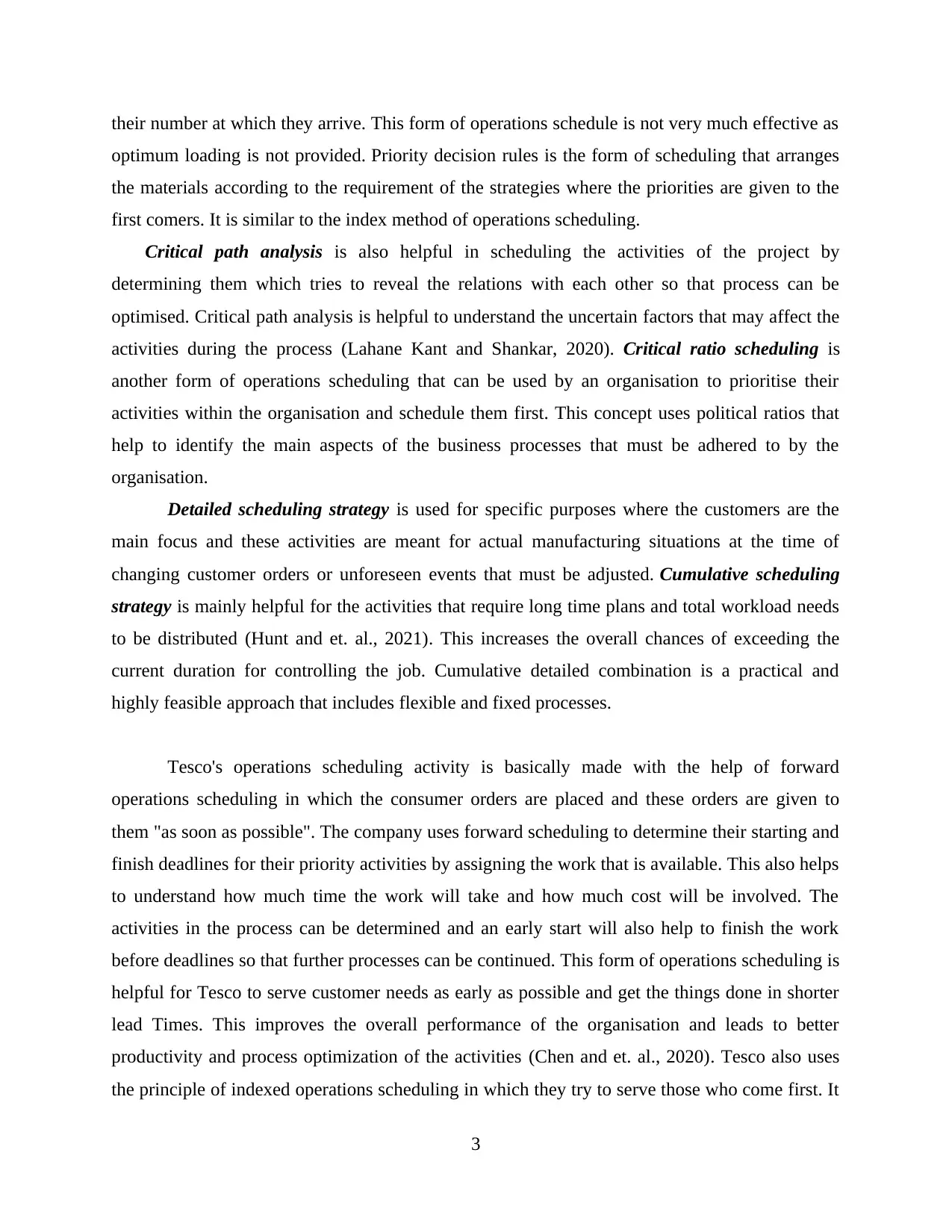
their number at which they arrive. This form of operations schedule is not very much effective as
optimum loading is not provided. Priority decision rules is the form of scheduling that arranges
the materials according to the requirement of the strategies where the priorities are given to the
first comers. It is similar to the index method of operations scheduling.
Critical path analysis is also helpful in scheduling the activities of the project by
determining them which tries to reveal the relations with each other so that process can be
optimised. Critical path analysis is helpful to understand the uncertain factors that may affect the
activities during the process (Lahane Kant and Shankar, 2020). Critical ratio scheduling is
another form of operations scheduling that can be used by an organisation to prioritise their
activities within the organisation and schedule them first. This concept uses political ratios that
help to identify the main aspects of the business processes that must be adhered to by the
organisation.
Detailed scheduling strategy is used for specific purposes where the customers are the
main focus and these activities are meant for actual manufacturing situations at the time of
changing customer orders or unforeseen events that must be adjusted. Cumulative scheduling
strategy is mainly helpful for the activities that require long time plans and total workload needs
to be distributed (Hunt and et. al., 2021). This increases the overall chances of exceeding the
current duration for controlling the job. Cumulative detailed combination is a practical and
highly feasible approach that includes flexible and fixed processes.
Tesco's operations scheduling activity is basically made with the help of forward
operations scheduling in which the consumer orders are placed and these orders are given to
them "as soon as possible". The company uses forward scheduling to determine their starting and
finish deadlines for their priority activities by assigning the work that is available. This also helps
to understand how much time the work will take and how much cost will be involved. The
activities in the process can be determined and an early start will also help to finish the work
before deadlines so that further processes can be continued. This form of operations scheduling is
helpful for Tesco to serve customer needs as early as possible and get the things done in shorter
lead Times. This improves the overall performance of the organisation and leads to better
productivity and process optimization of the activities (Chen and et. al., 2020). Tesco also uses
the principle of indexed operations scheduling in which they try to serve those who come first. It
3
optimum loading is not provided. Priority decision rules is the form of scheduling that arranges
the materials according to the requirement of the strategies where the priorities are given to the
first comers. It is similar to the index method of operations scheduling.
Critical path analysis is also helpful in scheduling the activities of the project by
determining them which tries to reveal the relations with each other so that process can be
optimised. Critical path analysis is helpful to understand the uncertain factors that may affect the
activities during the process (Lahane Kant and Shankar, 2020). Critical ratio scheduling is
another form of operations scheduling that can be used by an organisation to prioritise their
activities within the organisation and schedule them first. This concept uses political ratios that
help to identify the main aspects of the business processes that must be adhered to by the
organisation.
Detailed scheduling strategy is used for specific purposes where the customers are the
main focus and these activities are meant for actual manufacturing situations at the time of
changing customer orders or unforeseen events that must be adjusted. Cumulative scheduling
strategy is mainly helpful for the activities that require long time plans and total workload needs
to be distributed (Hunt and et. al., 2021). This increases the overall chances of exceeding the
current duration for controlling the job. Cumulative detailed combination is a practical and
highly feasible approach that includes flexible and fixed processes.
Tesco's operations scheduling activity is basically made with the help of forward
operations scheduling in which the consumer orders are placed and these orders are given to
them "as soon as possible". The company uses forward scheduling to determine their starting and
finish deadlines for their priority activities by assigning the work that is available. This also helps
to understand how much time the work will take and how much cost will be involved. The
activities in the process can be determined and an early start will also help to finish the work
before deadlines so that further processes can be continued. This form of operations scheduling is
helpful for Tesco to serve customer needs as early as possible and get the things done in shorter
lead Times. This improves the overall performance of the organisation and leads to better
productivity and process optimization of the activities (Chen and et. al., 2020). Tesco also uses
the principle of indexed operations scheduling in which they try to serve those who come first. It
3
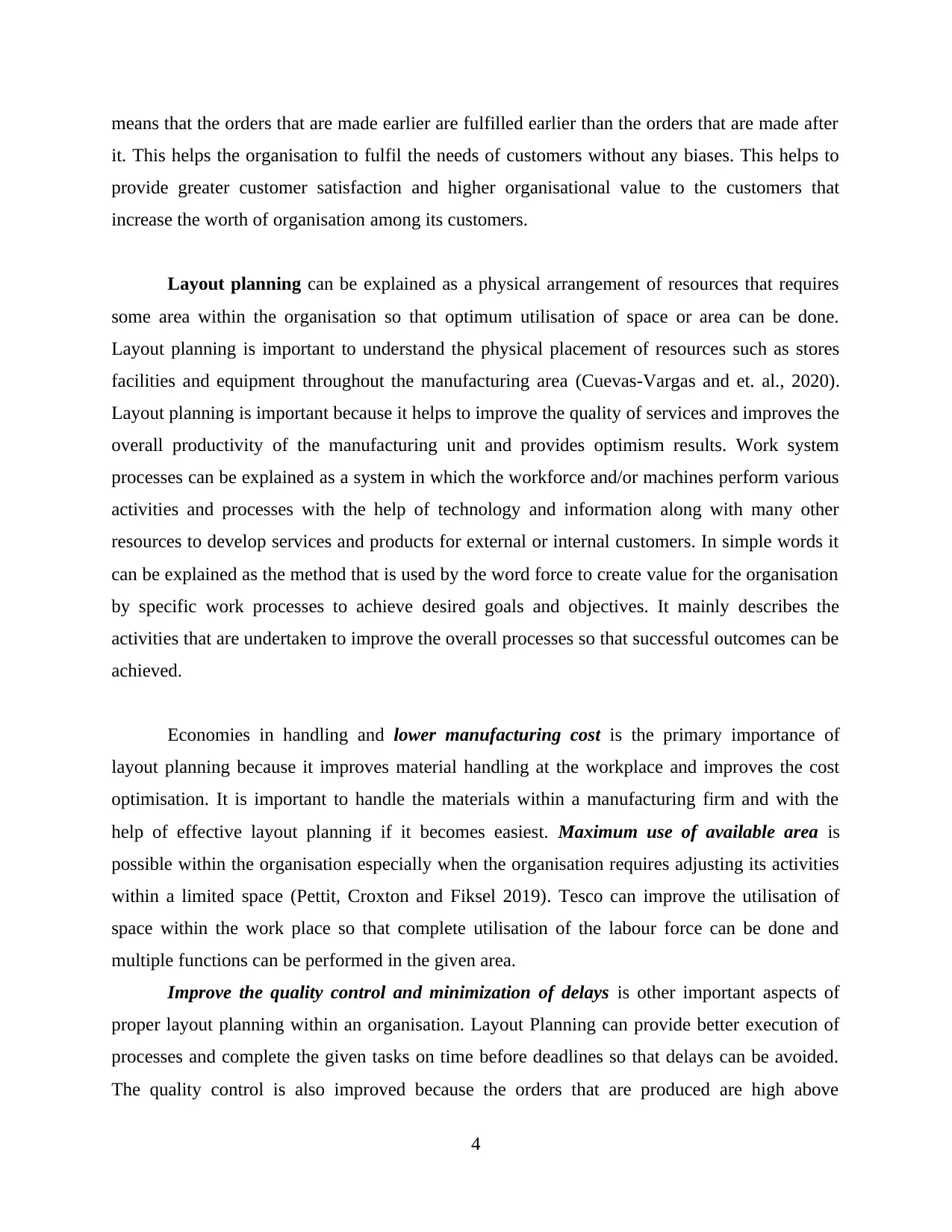
means that the orders that are made earlier are fulfilled earlier than the orders that are made after
it. This helps the organisation to fulfil the needs of customers without any biases. This helps to
provide greater customer satisfaction and higher organisational value to the customers that
increase the worth of organisation among its customers.
Layout planning can be explained as a physical arrangement of resources that requires
some area within the organisation so that optimum utilisation of space or area can be done.
Layout planning is important to understand the physical placement of resources such as stores
facilities and equipment throughout the manufacturing area (Cuevas-Vargas and et. al., 2020).
Layout planning is important because it helps to improve the quality of services and improves the
overall productivity of the manufacturing unit and provides optimism results. Work system
processes can be explained as a system in which the workforce and/or machines perform various
activities and processes with the help of technology and information along with many other
resources to develop services and products for external or internal customers. In simple words it
can be explained as the method that is used by the word force to create value for the organisation
by specific work processes to achieve desired goals and objectives. It mainly describes the
activities that are undertaken to improve the overall processes so that successful outcomes can be
achieved.
Economies in handling and lower manufacturing cost is the primary importance of
layout planning because it improves material handling at the workplace and improves the cost
optimisation. It is important to handle the materials within a manufacturing firm and with the
help of effective layout planning if it becomes easiest. Maximum use of available area is
possible within the organisation especially when the organisation requires adjusting its activities
within a limited space (Pettit, Croxton and Fiksel 2019). Tesco can improve the utilisation of
space within the work place so that complete utilisation of the labour force can be done and
multiple functions can be performed in the given area.
Improve the quality control and minimization of delays is other important aspects of
proper layout planning within an organisation. Layout Planning can provide better execution of
processes and complete the given tasks on time before deadlines so that delays can be avoided.
The quality control is also improved because the orders that are produced are high above
4
it. This helps the organisation to fulfil the needs of customers without any biases. This helps to
provide greater customer satisfaction and higher organisational value to the customers that
increase the worth of organisation among its customers.
Layout planning can be explained as a physical arrangement of resources that requires
some area within the organisation so that optimum utilisation of space or area can be done.
Layout planning is important to understand the physical placement of resources such as stores
facilities and equipment throughout the manufacturing area (Cuevas-Vargas and et. al., 2020).
Layout planning is important because it helps to improve the quality of services and improves the
overall productivity of the manufacturing unit and provides optimism results. Work system
processes can be explained as a system in which the workforce and/or machines perform various
activities and processes with the help of technology and information along with many other
resources to develop services and products for external or internal customers. In simple words it
can be explained as the method that is used by the word force to create value for the organisation
by specific work processes to achieve desired goals and objectives. It mainly describes the
activities that are undertaken to improve the overall processes so that successful outcomes can be
achieved.
Economies in handling and lower manufacturing cost is the primary importance of
layout planning because it improves material handling at the workplace and improves the cost
optimisation. It is important to handle the materials within a manufacturing firm and with the
help of effective layout planning if it becomes easiest. Maximum use of available area is
possible within the organisation especially when the organisation requires adjusting its activities
within a limited space (Pettit, Croxton and Fiksel 2019). Tesco can improve the utilisation of
space within the work place so that complete utilisation of the labour force can be done and
multiple functions can be performed in the given area.
Improve the quality control and minimization of delays is other important aspects of
proper layout planning within an organisation. Layout Planning can provide better execution of
processes and complete the given tasks on time before deadlines so that delays can be avoided.
The quality control is also improved because the orders that are produced are high above
4
⊘ This is a preview!⊘
Do you want full access?
Subscribe today to unlock all pages.

Trusted by 1+ million students worldwide
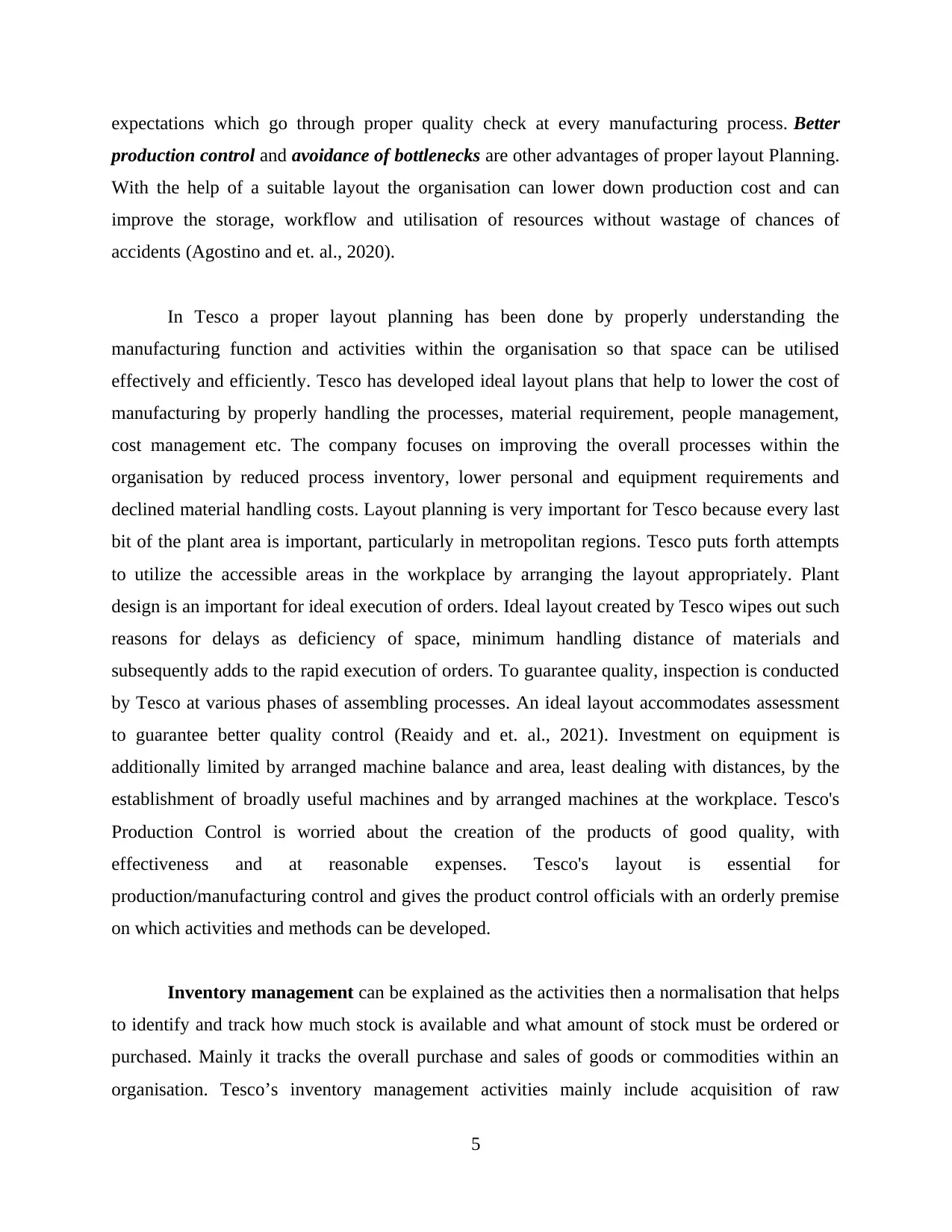
expectations which go through proper quality check at every manufacturing process. Better
production control and avoidance of bottlenecks are other advantages of proper layout Planning.
With the help of a suitable layout the organisation can lower down production cost and can
improve the storage, workflow and utilisation of resources without wastage of chances of
accidents (Agostino and et. al., 2020).
In Tesco a proper layout planning has been done by properly understanding the
manufacturing function and activities within the organisation so that space can be utilised
effectively and efficiently. Tesco has developed ideal layout plans that help to lower the cost of
manufacturing by properly handling the processes, material requirement, people management,
cost management etc. The company focuses on improving the overall processes within the
organisation by reduced process inventory, lower personal and equipment requirements and
declined material handling costs. Layout planning is very important for Tesco because every last
bit of the plant area is important, particularly in metropolitan regions. Tesco puts forth attempts
to utilize the accessible areas in the workplace by arranging the layout appropriately. Plant
design is an important for ideal execution of orders. Ideal layout created by Tesco wipes out such
reasons for delays as deficiency of space, minimum handling distance of materials and
subsequently adds to the rapid execution of orders. To guarantee quality, inspection is conducted
by Tesco at various phases of assembling processes. An ideal layout accommodates assessment
to guarantee better quality control (Reaidy and et. al., 2021). Investment on equipment is
additionally limited by arranged machine balance and area, least dealing with distances, by the
establishment of broadly useful machines and by arranged machines at the workplace. Tesco's
Production Control is worried about the creation of the products of good quality, with
effectiveness and at reasonable expenses. Tesco's layout is essential for
production/manufacturing control and gives the product control officials with an orderly premise
on which activities and methods can be developed.
Inventory management can be explained as the activities then a normalisation that helps
to identify and track how much stock is available and what amount of stock must be ordered or
purchased. Mainly it tracks the overall purchase and sales of goods or commodities within an
organisation. Tesco’s inventory management activities mainly include acquisition of raw
5
production control and avoidance of bottlenecks are other advantages of proper layout Planning.
With the help of a suitable layout the organisation can lower down production cost and can
improve the storage, workflow and utilisation of resources without wastage of chances of
accidents (Agostino and et. al., 2020).
In Tesco a proper layout planning has been done by properly understanding the
manufacturing function and activities within the organisation so that space can be utilised
effectively and efficiently. Tesco has developed ideal layout plans that help to lower the cost of
manufacturing by properly handling the processes, material requirement, people management,
cost management etc. The company focuses on improving the overall processes within the
organisation by reduced process inventory, lower personal and equipment requirements and
declined material handling costs. Layout planning is very important for Tesco because every last
bit of the plant area is important, particularly in metropolitan regions. Tesco puts forth attempts
to utilize the accessible areas in the workplace by arranging the layout appropriately. Plant
design is an important for ideal execution of orders. Ideal layout created by Tesco wipes out such
reasons for delays as deficiency of space, minimum handling distance of materials and
subsequently adds to the rapid execution of orders. To guarantee quality, inspection is conducted
by Tesco at various phases of assembling processes. An ideal layout accommodates assessment
to guarantee better quality control (Reaidy and et. al., 2021). Investment on equipment is
additionally limited by arranged machine balance and area, least dealing with distances, by the
establishment of broadly useful machines and by arranged machines at the workplace. Tesco's
Production Control is worried about the creation of the products of good quality, with
effectiveness and at reasonable expenses. Tesco's layout is essential for
production/manufacturing control and gives the product control officials with an orderly premise
on which activities and methods can be developed.
Inventory management can be explained as the activities then a normalisation that helps
to identify and track how much stock is available and what amount of stock must be ordered or
purchased. Mainly it tracks the overall purchase and sales of goods or commodities within an
organisation. Tesco’s inventory management activities mainly include acquisition of raw
5
Paraphrase This Document
Need a fresh take? Get an instant paraphrase of this document with our AI Paraphraser
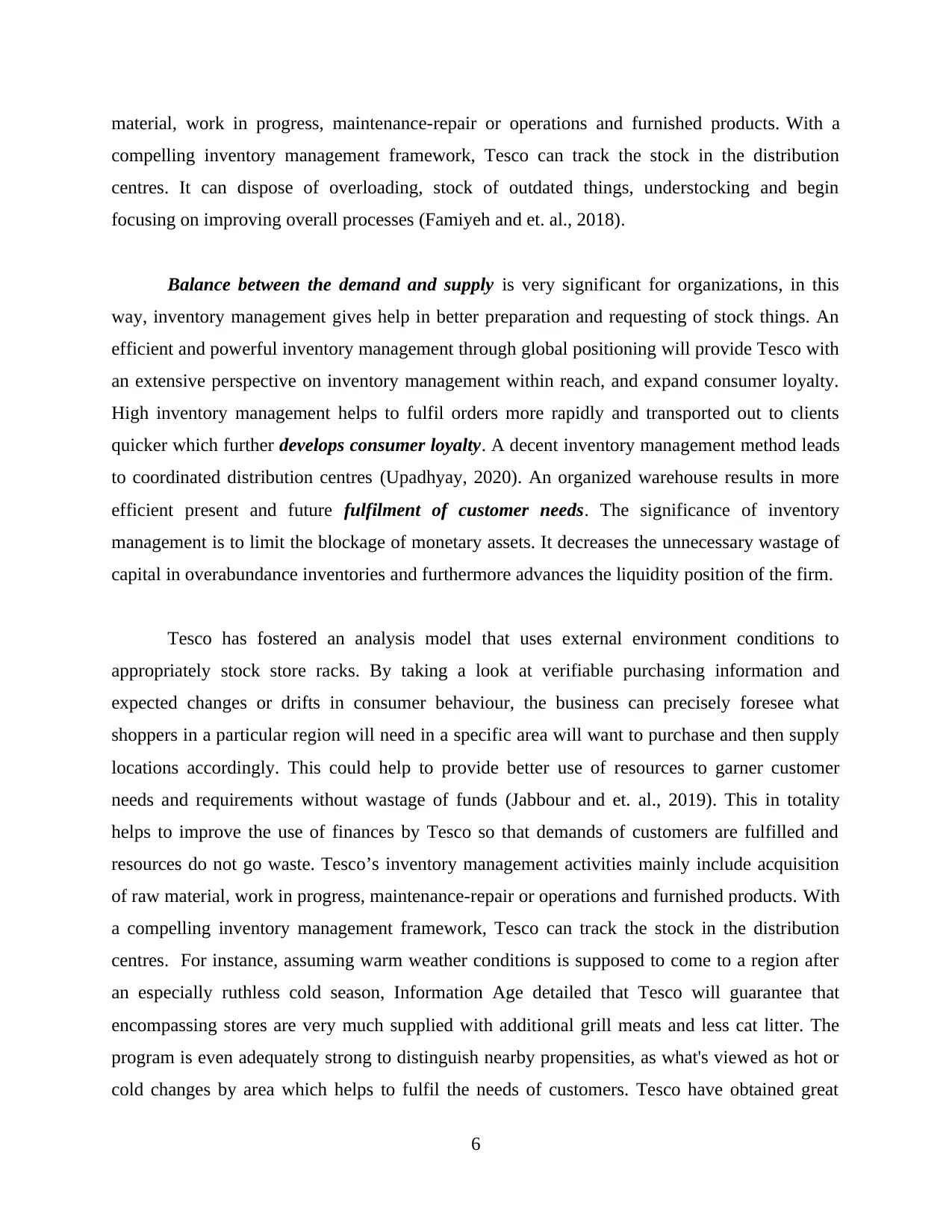
material, work in progress, maintenance-repair or operations and furnished products. With a
compelling inventory management framework, Tesco can track the stock in the distribution
centres. It can dispose of overloading, stock of outdated things, understocking and begin
focusing on improving overall processes (Famiyeh and et. al., 2018).
Balance between the demand and supply is very significant for organizations, in this
way, inventory management gives help in better preparation and requesting of stock things. An
efficient and powerful inventory management through global positioning will provide Tesco with
an extensive perspective on inventory management within reach, and expand consumer loyalty.
High inventory management helps to fulfil orders more rapidly and transported out to clients
quicker which further develops consumer loyalty. A decent inventory management method leads
to coordinated distribution centres (Upadhyay, 2020). An organized warehouse results in more
efficient present and future fulfilment of customer needs. The significance of inventory
management is to limit the blockage of monetary assets. It decreases the unnecessary wastage of
capital in overabundance inventories and furthermore advances the liquidity position of the firm.
Tesco has fostered an analysis model that uses external environment conditions to
appropriately stock store racks. By taking a look at verifiable purchasing information and
expected changes or drifts in consumer behaviour, the business can precisely foresee what
shoppers in a particular region will need in a specific area will want to purchase and then supply
locations accordingly. This could help to provide better use of resources to garner customer
needs and requirements without wastage of funds (Jabbour and et. al., 2019). This in totality
helps to improve the use of finances by Tesco so that demands of customers are fulfilled and
resources do not go waste. Tesco’s inventory management activities mainly include acquisition
of raw material, work in progress, maintenance-repair or operations and furnished products. With
a compelling inventory management framework, Tesco can track the stock in the distribution
centres. For instance, assuming warm weather conditions is supposed to come to a region after
an especially ruthless cold season, Information Age detailed that Tesco will guarantee that
encompassing stores are very much supplied with additional grill meats and less cat litter. The
program is even adequately strong to distinguish nearby propensities, as what's viewed as hot or
cold changes by area which helps to fulfil the needs of customers. Tesco have obtained great
6
compelling inventory management framework, Tesco can track the stock in the distribution
centres. It can dispose of overloading, stock of outdated things, understocking and begin
focusing on improving overall processes (Famiyeh and et. al., 2018).
Balance between the demand and supply is very significant for organizations, in this
way, inventory management gives help in better preparation and requesting of stock things. An
efficient and powerful inventory management through global positioning will provide Tesco with
an extensive perspective on inventory management within reach, and expand consumer loyalty.
High inventory management helps to fulfil orders more rapidly and transported out to clients
quicker which further develops consumer loyalty. A decent inventory management method leads
to coordinated distribution centres (Upadhyay, 2020). An organized warehouse results in more
efficient present and future fulfilment of customer needs. The significance of inventory
management is to limit the blockage of monetary assets. It decreases the unnecessary wastage of
capital in overabundance inventories and furthermore advances the liquidity position of the firm.
Tesco has fostered an analysis model that uses external environment conditions to
appropriately stock store racks. By taking a look at verifiable purchasing information and
expected changes or drifts in consumer behaviour, the business can precisely foresee what
shoppers in a particular region will need in a specific area will want to purchase and then supply
locations accordingly. This could help to provide better use of resources to garner customer
needs and requirements without wastage of funds (Jabbour and et. al., 2019). This in totality
helps to improve the use of finances by Tesco so that demands of customers are fulfilled and
resources do not go waste. Tesco’s inventory management activities mainly include acquisition
of raw material, work in progress, maintenance-repair or operations and furnished products. With
a compelling inventory management framework, Tesco can track the stock in the distribution
centres. For instance, assuming warm weather conditions is supposed to come to a region after
an especially ruthless cold season, Information Age detailed that Tesco will guarantee that
encompassing stores are very much supplied with additional grill meats and less cat litter. The
program is even adequately strong to distinguish nearby propensities, as what's viewed as hot or
cold changes by area which helps to fulfil the needs of customers. Tesco have obtained great
6
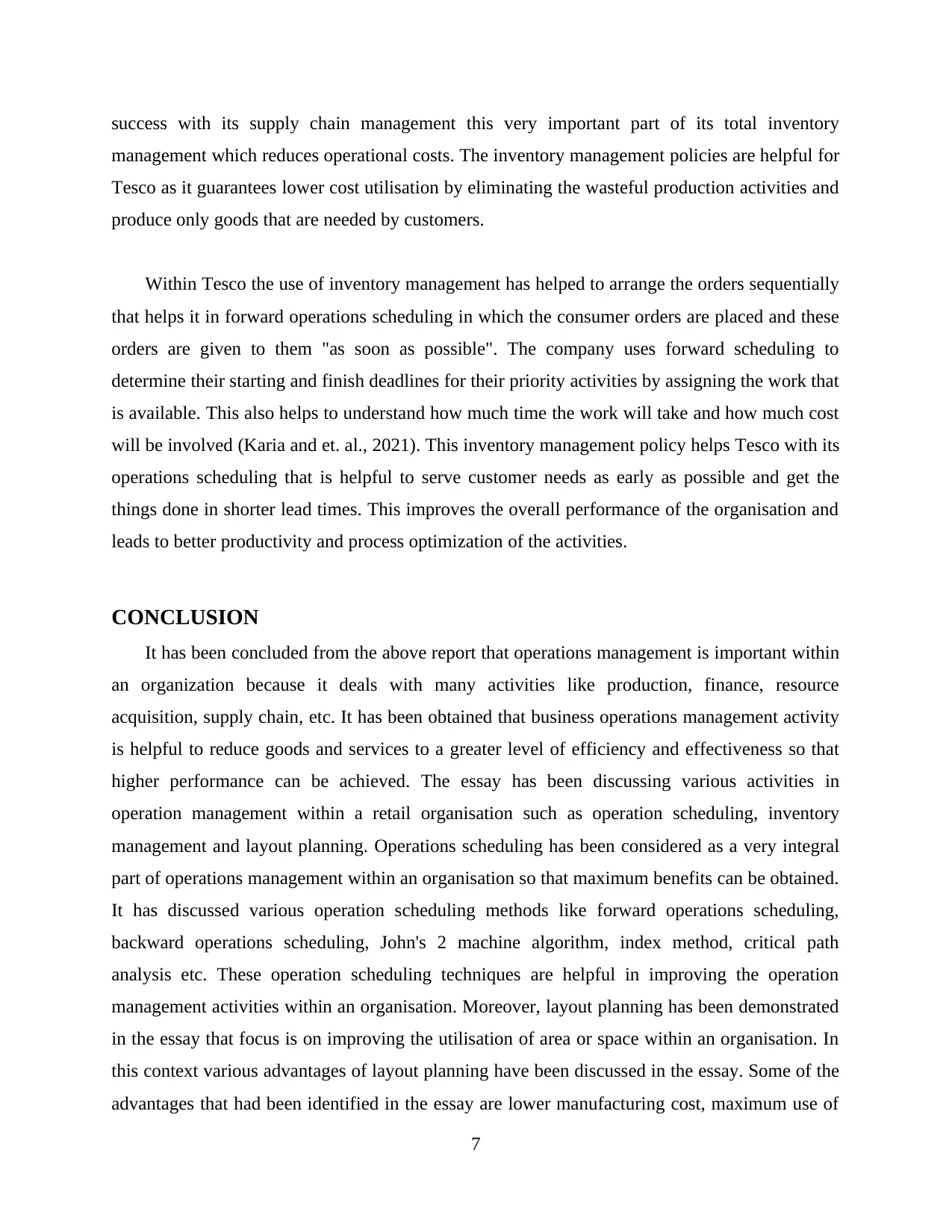
success with its supply chain management this very important part of its total inventory
management which reduces operational costs. The inventory management policies are helpful for
Tesco as it guarantees lower cost utilisation by eliminating the wasteful production activities and
produce only goods that are needed by customers.
Within Tesco the use of inventory management has helped to arrange the orders sequentially
that helps it in forward operations scheduling in which the consumer orders are placed and these
orders are given to them "as soon as possible". The company uses forward scheduling to
determine their starting and finish deadlines for their priority activities by assigning the work that
is available. This also helps to understand how much time the work will take and how much cost
will be involved (Karia and et. al., 2021). This inventory management policy helps Tesco with its
operations scheduling that is helpful to serve customer needs as early as possible and get the
things done in shorter lead times. This improves the overall performance of the organisation and
leads to better productivity and process optimization of the activities.
CONCLUSION
It has been concluded from the above report that operations management is important within
an organization because it deals with many activities like production, finance, resource
acquisition, supply chain, etc. It has been obtained that business operations management activity
is helpful to reduce goods and services to a greater level of efficiency and effectiveness so that
higher performance can be achieved. The essay has been discussing various activities in
operation management within a retail organisation such as operation scheduling, inventory
management and layout planning. Operations scheduling has been considered as a very integral
part of operations management within an organisation so that maximum benefits can be obtained.
It has discussed various operation scheduling methods like forward operations scheduling,
backward operations scheduling, John's 2 machine algorithm, index method, critical path
analysis etc. These operation scheduling techniques are helpful in improving the operation
management activities within an organisation. Moreover, layout planning has been demonstrated
in the essay that focus is on improving the utilisation of area or space within an organisation. In
this context various advantages of layout planning have been discussed in the essay. Some of the
advantages that had been identified in the essay are lower manufacturing cost, maximum use of
7
management which reduces operational costs. The inventory management policies are helpful for
Tesco as it guarantees lower cost utilisation by eliminating the wasteful production activities and
produce only goods that are needed by customers.
Within Tesco the use of inventory management has helped to arrange the orders sequentially
that helps it in forward operations scheduling in which the consumer orders are placed and these
orders are given to them "as soon as possible". The company uses forward scheduling to
determine their starting and finish deadlines for their priority activities by assigning the work that
is available. This also helps to understand how much time the work will take and how much cost
will be involved (Karia and et. al., 2021). This inventory management policy helps Tesco with its
operations scheduling that is helpful to serve customer needs as early as possible and get the
things done in shorter lead times. This improves the overall performance of the organisation and
leads to better productivity and process optimization of the activities.
CONCLUSION
It has been concluded from the above report that operations management is important within
an organization because it deals with many activities like production, finance, resource
acquisition, supply chain, etc. It has been obtained that business operations management activity
is helpful to reduce goods and services to a greater level of efficiency and effectiveness so that
higher performance can be achieved. The essay has been discussing various activities in
operation management within a retail organisation such as operation scheduling, inventory
management and layout planning. Operations scheduling has been considered as a very integral
part of operations management within an organisation so that maximum benefits can be obtained.
It has discussed various operation scheduling methods like forward operations scheduling,
backward operations scheduling, John's 2 machine algorithm, index method, critical path
analysis etc. These operation scheduling techniques are helpful in improving the operation
management activities within an organisation. Moreover, layout planning has been demonstrated
in the essay that focus is on improving the utilisation of area or space within an organisation. In
this context various advantages of layout planning have been discussed in the essay. Some of the
advantages that had been identified in the essay are lower manufacturing cost, maximum use of
7
⊘ This is a preview!⊘
Do you want full access?
Subscribe today to unlock all pages.

Trusted by 1+ million students worldwide
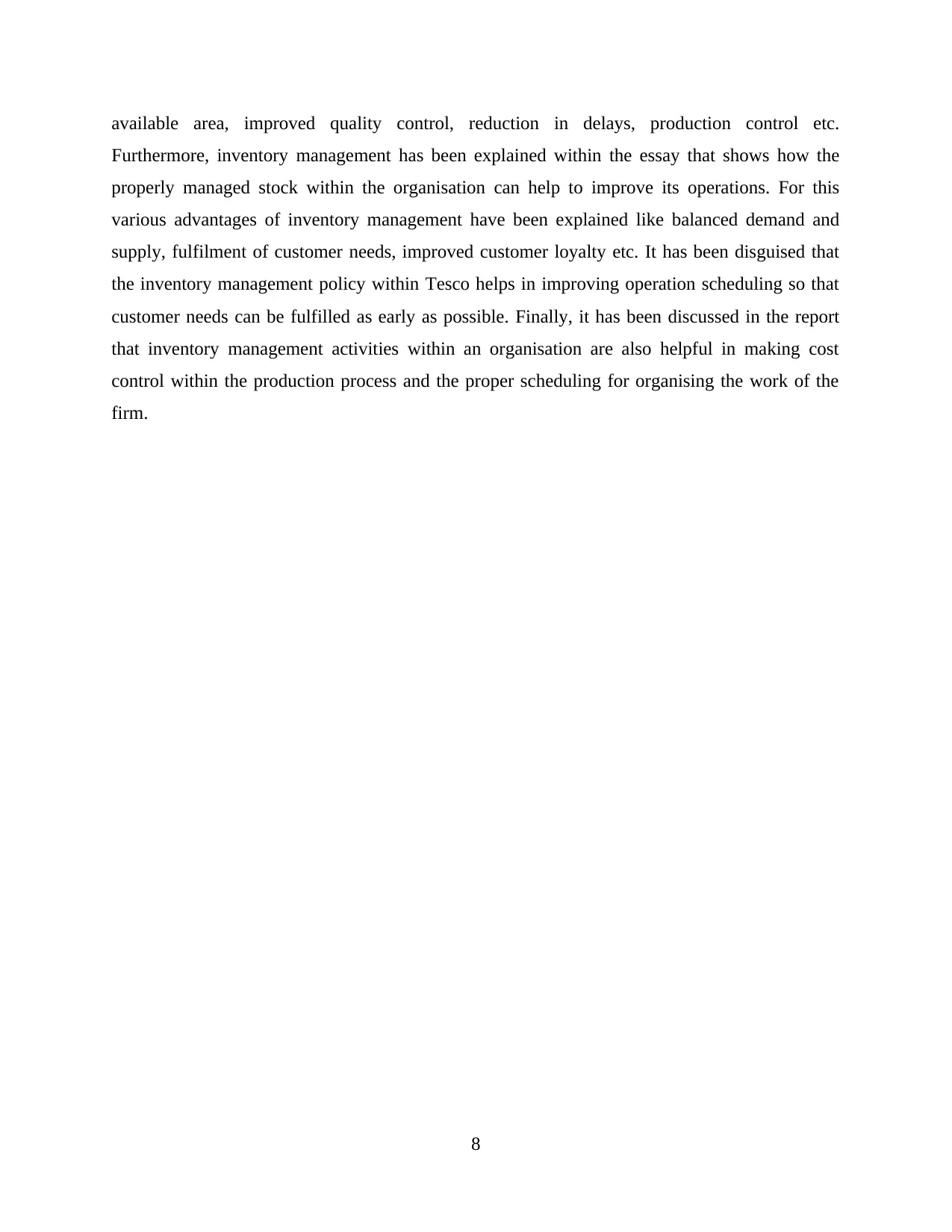
available area, improved quality control, reduction in delays, production control etc.
Furthermore, inventory management has been explained within the essay that shows how the
properly managed stock within the organisation can help to improve its operations. For this
various advantages of inventory management have been explained like balanced demand and
supply, fulfilment of customer needs, improved customer loyalty etc. It has been disguised that
the inventory management policy within Tesco helps in improving operation scheduling so that
customer needs can be fulfilled as early as possible. Finally, it has been discussed in the report
that inventory management activities within an organisation are also helpful in making cost
control within the production process and the proper scheduling for organising the work of the
firm.
8
Furthermore, inventory management has been explained within the essay that shows how the
properly managed stock within the organisation can help to improve its operations. For this
various advantages of inventory management have been explained like balanced demand and
supply, fulfilment of customer needs, improved customer loyalty etc. It has been disguised that
the inventory management policy within Tesco helps in improving operation scheduling so that
customer needs can be fulfilled as early as possible. Finally, it has been discussed in the report
that inventory management activities within an organisation are also helpful in making cost
control within the production process and the proper scheduling for organising the work of the
firm.
8
Paraphrase This Document
Need a fresh take? Get an instant paraphrase of this document with our AI Paraphraser
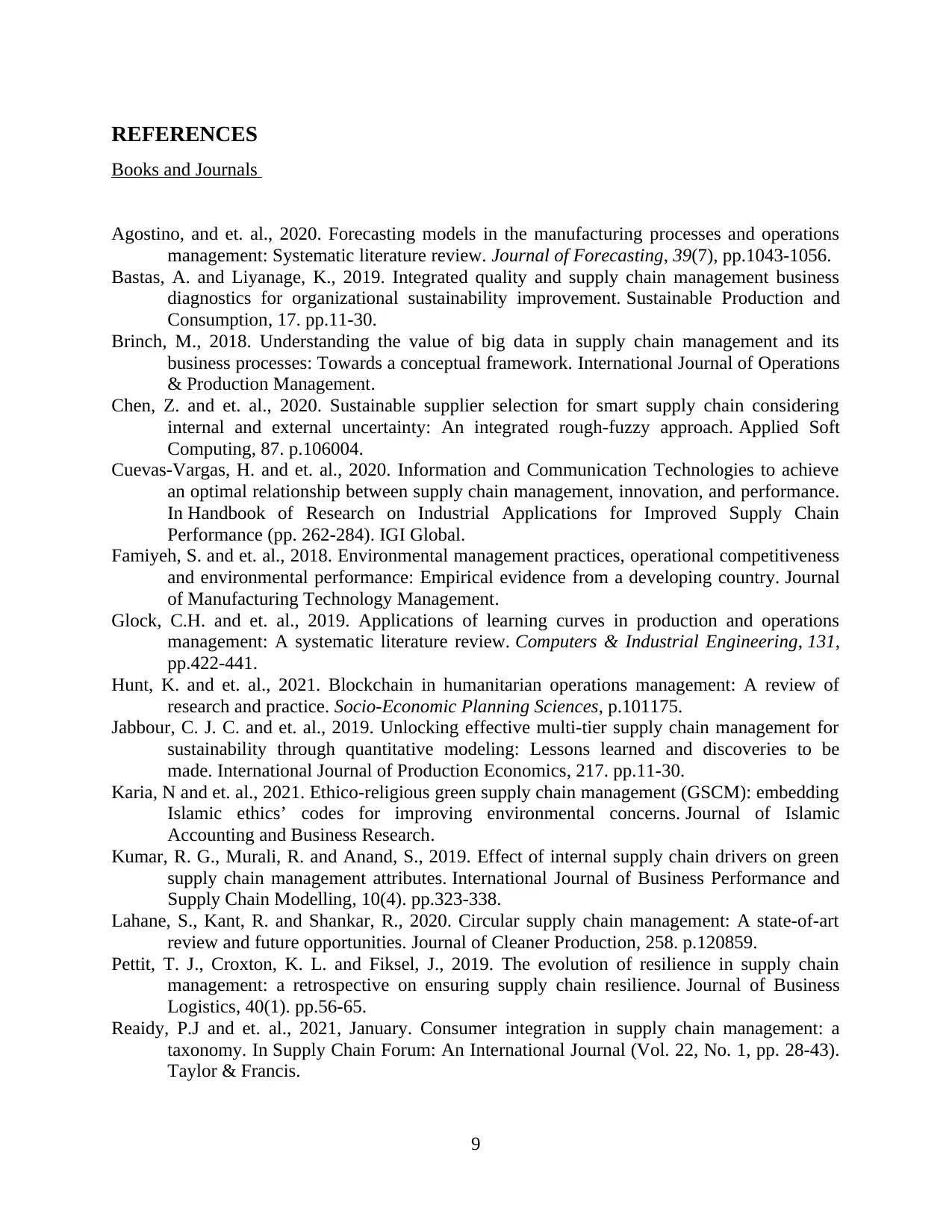
REFERENCES
Books and Journals
Agostino, and et. al., 2020. Forecasting models in the manufacturing processes and operations
management: Systematic literature review. Journal of Forecasting, 39(7), pp.1043-1056.
Bastas, A. and Liyanage, K., 2019. Integrated quality and supply chain management business
diagnostics for organizational sustainability improvement. Sustainable Production and
Consumption, 17. pp.11-30.
Brinch, M., 2018. Understanding the value of big data in supply chain management and its
business processes: Towards a conceptual framework. International Journal of Operations
& Production Management.
Chen, Z. and et. al., 2020. Sustainable supplier selection for smart supply chain considering
internal and external uncertainty: An integrated rough-fuzzy approach. Applied Soft
Computing, 87. p.106004.
Cuevas-Vargas, H. and et. al., 2020. Information and Communication Technologies to achieve
an optimal relationship between supply chain management, innovation, and performance.
In Handbook of Research on Industrial Applications for Improved Supply Chain
Performance (pp. 262-284). IGI Global.
Famiyeh, S. and et. al., 2018. Environmental management practices, operational competitiveness
and environmental performance: Empirical evidence from a developing country. Journal
of Manufacturing Technology Management.
Glock, C.H. and et. al., 2019. Applications of learning curves in production and operations
management: A systematic literature review. Computers & Industrial Engineering, 131,
pp.422-441.
Hunt, K. and et. al., 2021. Blockchain in humanitarian operations management: A review of
research and practice. Socio-Economic Planning Sciences, p.101175.
Jabbour, C. J. C. and et. al., 2019. Unlocking effective multi-tier supply chain management for
sustainability through quantitative modeling: Lessons learned and discoveries to be
made. International Journal of Production Economics, 217. pp.11-30.
Karia, N and et. al., 2021. Ethico-religious green supply chain management (GSCM): embedding
Islamic ethics’ codes for improving environmental concerns. Journal of Islamic
Accounting and Business Research.
Kumar, R. G., Murali, R. and Anand, S., 2019. Effect of internal supply chain drivers on green
supply chain management attributes. International Journal of Business Performance and
Supply Chain Modelling, 10(4). pp.323-338.
Lahane, S., Kant, R. and Shankar, R., 2020. Circular supply chain management: A state-of-art
review and future opportunities. Journal of Cleaner Production, 258. p.120859.
Pettit, T. J., Croxton, K. L. and Fiksel, J., 2019. The evolution of resilience in supply chain
management: a retrospective on ensuring supply chain resilience. Journal of Business
Logistics, 40(1). pp.56-65.
Reaidy, P.J and et. al., 2021, January. Consumer integration in supply chain management: a
taxonomy. In Supply Chain Forum: An International Journal (Vol. 22, No. 1, pp. 28-43).
Taylor & Francis.
9
Books and Journals
Agostino, and et. al., 2020. Forecasting models in the manufacturing processes and operations
management: Systematic literature review. Journal of Forecasting, 39(7), pp.1043-1056.
Bastas, A. and Liyanage, K., 2019. Integrated quality and supply chain management business
diagnostics for organizational sustainability improvement. Sustainable Production and
Consumption, 17. pp.11-30.
Brinch, M., 2018. Understanding the value of big data in supply chain management and its
business processes: Towards a conceptual framework. International Journal of Operations
& Production Management.
Chen, Z. and et. al., 2020. Sustainable supplier selection for smart supply chain considering
internal and external uncertainty: An integrated rough-fuzzy approach. Applied Soft
Computing, 87. p.106004.
Cuevas-Vargas, H. and et. al., 2020. Information and Communication Technologies to achieve
an optimal relationship between supply chain management, innovation, and performance.
In Handbook of Research on Industrial Applications for Improved Supply Chain
Performance (pp. 262-284). IGI Global.
Famiyeh, S. and et. al., 2018. Environmental management practices, operational competitiveness
and environmental performance: Empirical evidence from a developing country. Journal
of Manufacturing Technology Management.
Glock, C.H. and et. al., 2019. Applications of learning curves in production and operations
management: A systematic literature review. Computers & Industrial Engineering, 131,
pp.422-441.
Hunt, K. and et. al., 2021. Blockchain in humanitarian operations management: A review of
research and practice. Socio-Economic Planning Sciences, p.101175.
Jabbour, C. J. C. and et. al., 2019. Unlocking effective multi-tier supply chain management for
sustainability through quantitative modeling: Lessons learned and discoveries to be
made. International Journal of Production Economics, 217. pp.11-30.
Karia, N and et. al., 2021. Ethico-religious green supply chain management (GSCM): embedding
Islamic ethics’ codes for improving environmental concerns. Journal of Islamic
Accounting and Business Research.
Kumar, R. G., Murali, R. and Anand, S., 2019. Effect of internal supply chain drivers on green
supply chain management attributes. International Journal of Business Performance and
Supply Chain Modelling, 10(4). pp.323-338.
Lahane, S., Kant, R. and Shankar, R., 2020. Circular supply chain management: A state-of-art
review and future opportunities. Journal of Cleaner Production, 258. p.120859.
Pettit, T. J., Croxton, K. L. and Fiksel, J., 2019. The evolution of resilience in supply chain
management: a retrospective on ensuring supply chain resilience. Journal of Business
Logistics, 40(1). pp.56-65.
Reaidy, P.J and et. al., 2021, January. Consumer integration in supply chain management: a
taxonomy. In Supply Chain Forum: An International Journal (Vol. 22, No. 1, pp. 28-43).
Taylor & Francis.
9
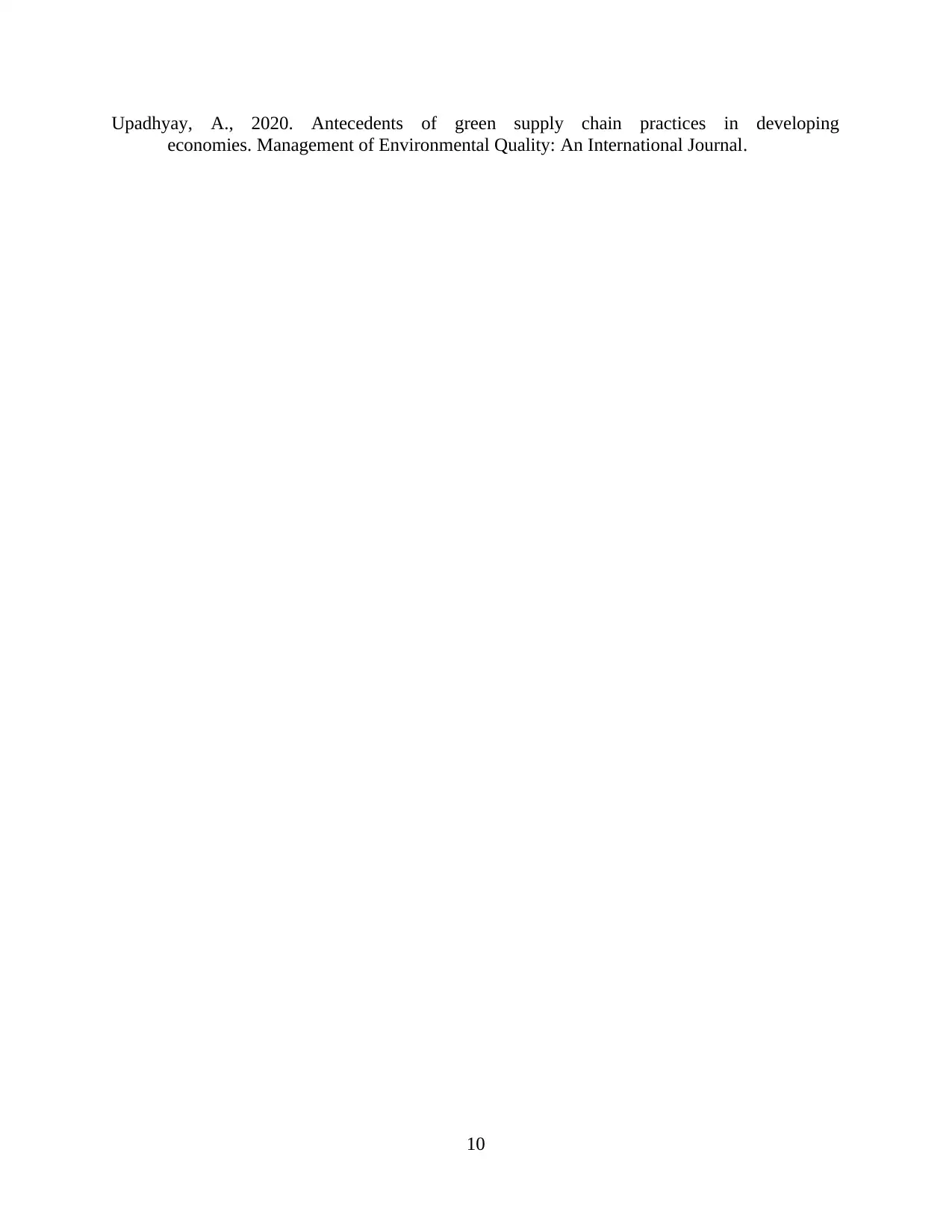
Upadhyay, A., 2020. Antecedents of green supply chain practices in developing
economies. Management of Environmental Quality: An International Journal.
10
economies. Management of Environmental Quality: An International Journal.
10
⊘ This is a preview!⊘
Do you want full access?
Subscribe today to unlock all pages.

Trusted by 1+ million students worldwide
1 out of 12
Related Documents
Your All-in-One AI-Powered Toolkit for Academic Success.
+13062052269
info@desklib.com
Available 24*7 on WhatsApp / Email
![[object Object]](/_next/static/media/star-bottom.7253800d.svg)
Unlock your academic potential
Copyright © 2020–2025 A2Z Services. All Rights Reserved. Developed and managed by ZUCOL.



